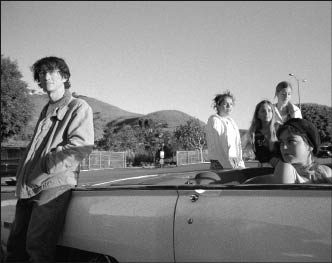Junior Noir
by M. Faust

Brick is an R-rated film about teenagers, drug dealers and murder which contains, to the best of my recollection, not a single instance of profanity.
Think about that for a moment. Teens tend to wield swearing as a cudgel of independence, long before they develop any facility for it. A mark of maturity in modern America (one that not everyone attains) is the knowledge that, like spices, one well-placed “fuck” is far more effective than a ceaseless barrage of them.
The teens who make up practically the entire cast of Brick never curse because they have a better tool in their verbal arsenals: wit. They have a blessing that real teenagers never do, dialogue provided by a scriptwriter who has honed their lines to a fine, sharp point.
This is an admittedly roundabout way of describing the central conceit of this, the first feature film by writer-director Rian Johnson. He has (bear with me here, this is going to sound awful at first) taken the well-worn conventions of a classic private eye tale, a la Dashiell Hammett or Raymond Chandler, and reset them in a modern California high school.
No, no, don’t run away! It’s a stunt, I admit, but Johnson pulls it off. He pulls it off so well, in fact, that after a while it starts to seem weirdly appropriate. There was always something stubbornly adolescent about the romantic cynicism of movie gumshoes like Sam Spade and Phillip Marlowe, with their refusal to stoop to the compromises that rule real life.
And what teenager, seldom armed with anything more than his mouth, hasn’t wanted to be able to devastate his opponents with no more than the curl of a lip and a little breath? (Sometimes more than a little: Surely star Joseph Gordon-Levitt must have practiced breathing his way through some of Johnson’s more ornate lines).
The plot of Brick is so archetypal as to render ironic the Sundance Special Jury Prize it received for “Originality of Vision.” Brendan (Gordon-Levitt), a loner who disdains the social climbing of his classmates, receives a desperate but muddled call for help from his ex-girlfriend Emily (Emilie de Ravin, of Lost). Before he can track her down, she turns up dead in a storm drain (echoes of the 1980s teen angst classic The River’s Edge). Determined to learn what happened to her, Brendan uncovers a treacherous criminal underworld replete with femmes fatale and a self-styled dark lord known only as the Pin (Lukas Haas).
There are times when we’re inclined to take the whole thing as a joke. But the fact of a murder keeps it grounded. Teenagers may take a lot of things too seriously, but death isn’t one of them. Though the dialogue often made me laugh with its wit, Johnson plays the plot straight. Only once does he slip in a reminder that we are after all watching teenagers, with the appearance of the Pin’s doting mother. It does provide a tinge of ridiculousness, though the Pin is fairly ridiculous in the first place, a sort of combination of Sydney Greenstreet and Bela Lugosi. Maybe this is a misstep on Johnson’s part; then again, maybe he felt that acknowledging the reality of his characters would dispel any notion that his whole film was a parody like Bugsy Malone (1976), which recreated a 1930s gangster movie with a cast of pre-teens (including Jodie Foster).
Much as I enjoyed it, I came away from Brick wondering who it was made for. How can it possibly look to audiences unfamiliar with Philip Marlowe? The same way, I suppose, that Down With Love must have looked to audiences unfamiliar with the Doris Day-Rock Hudson comedies it evoked. In a just world, Brick would be as big a hit with young viewers as Napoleon Dynamite: It certainly has much more quotable dialogue, and it doesn’t make you feel as if everyone in the world except you is a moron.
|
Issue Navigation> Issue Index > v5n23: Greed and the Demolition of the H-O Oats Elevator (6/8/06) > Film Reviews > Junior Noir This Week's Issue • Artvoice Daily • Artvoice TV • Events Calendar • Classifieds |









 Current Issue
Current Issue